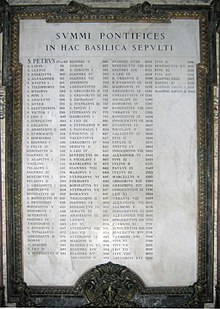Papal name
This article needs additional citations for verification. (March 2010) |

A papal name or pontificial name is the
While popes in the early centuries retained their birth names after their accession to the papacy, later popes began to adopt a new name upon their accession. This started in the sixth century and became customary in the tenth century. Since 1555, every pope has taken a papal name.
The pontificial name is given in Latin by virtue of the pope's status as
Title and honorifics
Catholic
The official
The full title, rarely used, of the Catholic pope in English is: "
Coptic
The
Within the Coptic Church, he is considered to be Father of Fathers, Shepherd of Shepherds, and Hierarch of all Hierarchs. Honorary titles attributed to the Hierarch of the Alexandrine Throne also include:
- The Pillar and Defender of the Holy, Catholic, Apostolic Church and of the Orthodox Faith
- The Dean of the Great Catechetical School of Theology of Alexandria
- The Ecumenical (Universal) Judge (Arbitrator) of the Holy Apostolic and Catholic (Universal) Church
- The Thirteenth among the Holy Apostles
History
During the first centuries of the church, the
The last pope to use his baptismal name was Marcellus II in 1555, a choice that was even then quite exceptional. Names are freely chosen by popes, and not based on any system. Names of immediate or distant predecessors, mentors, saints, or even family members – as was the case with John XXIII – have been adopted.
In 1978,
Symbolism
Often the new pontiff's choice of name upon being elected to the papacy is seen as a signal to the world of whom the new pope will emulate, what policies he will seek to enact, or even the length of his reign. Such was the case with
Saint Peter was the first pope; no bishop of Rome has chosen the name Peter II, although there is no prohibition against doing so. Since the 1970s, some antipopes, with only a minuscule following, took the name Pope Peter II.
Probably because of the controversial 15th-century
Current practice
Immediately after a new pope is elected, and accepts the election, he is asked in Latin "By what name shall you be called?"[a] The new pope chooses the name by which he will be known from that point on. The senior cardinal deacon or cardinal protodeacon then appears on the balcony of Saint Peter's to proclaim the new pope by his birth name, and announce his papal name:
Annuntio vobis gaudium magnum:
Habemus Papam!
Eminentissimum ac reverendissimum dominum,
dominum [baptismal name],
Sanctæ Romanæ Ecclesiæ Cardinalem [surname],
qui sibi nomen imposuit [papal name].
I announce to you a great joy:
We have a Pope!
The Most Eminent and Most Reverend Father,
Lord [baptismal name],
Cardinal of the Holy Roman Church [surname],
who takes to himself the name [papal name].
Papal names
The most frequently used papal name is John, with 21 popes taking this name. There have also been 44 papal names that have only been used once. The number of all popes to the present is 264; Pope Benedict IX was elected pope three times, therefore the number of pontificates is actually 266.[2]
Notes
- ^ Unless impeded, the dean of the College of Cardinals asks the newly elected pope if he accepts his election and what name he will use. In 2005, Cardinal Joseph Ratzinger, the dean, was himself elected pope, so these questions were asked by the subdean, Cardinal Angelo Sodano.
- ^ See Pope John numbering for further information.
- ^ The papacy of Benedict X was later declared illegitimate.
- ^ Additionally, some sources prior to the 1960s list Pope-elect Stephen, who died before his consecration, as Stephen II, thus causing a numbering discrepancy.
- ^ The papacy of Boniface VII was later declared illegitimate.
- ^ The papacy of Alexander V was later declared illegitimate.
- ^ The papacy of Felix II was later declared illegitimate.
- Martin III. Marinus I and Marinus IIwere mistakenly thought to be named "Martin(us)", causing the confusion.
Citations
- ^ AUDIENCE TO REPRESENTATIVES OF THE COMMUNICATIONS MEDIA – ADDRESS OF THE HOLY FATHER POPE FRANCIS – Vatican.va – Paul VI Audience Hall Saturday, 16 March 2013.
- Libreria Editrice Vaticana, 2002.
References
- McClintock, John. 1891. Cyclopaedia of Biblical, Theological, and Ecclesiastical Literature. Harper & Brothers. (Available online)
